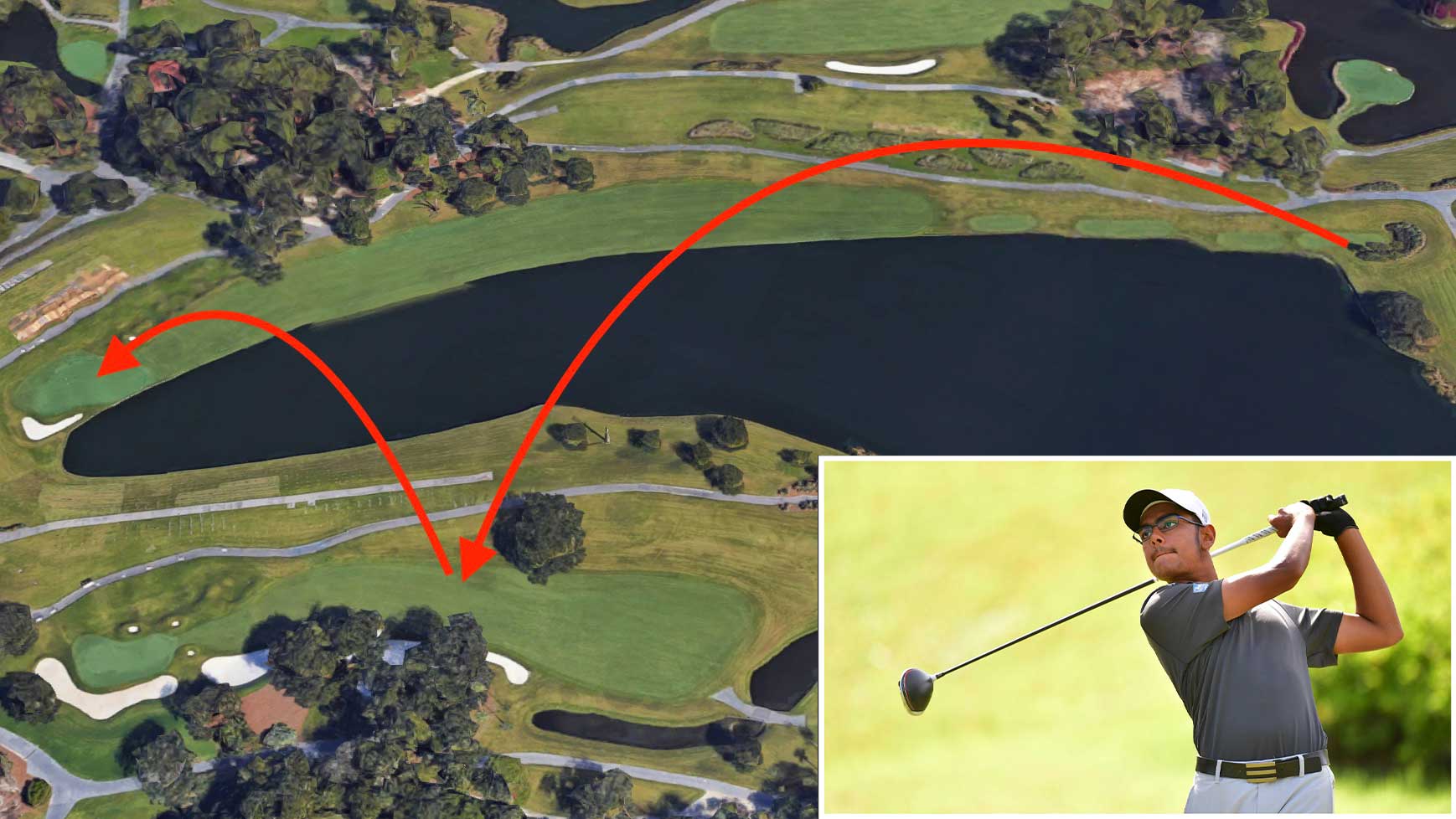The hazardous Stadium Course at TPC Sawgrass is not the type of test that golfers can easily outmuscle or, for that matter, outsmart. But on Sunday evening Bryson DeChambeau did float one ear-perking idea about how he might attack the water-lined par-4 18th hole at the Players Championship this week: by bombing his tee shot left — like, way left — over the lake to the 9th hole. As DeChambeau sees it, playing to that landing area would allow more room for error while still leaving a relatively straightforward approach.
“It’s probably not worth it,” he added. “I mean, the cover’s like 310, but we’ll see.”
Actually, no, we won’t see. On Tuesday, the PGA Tour announced that the area left of the lake on 18 has, for safety reasons, been designated as internal O.B., meaning DeChambeau will have to play the hole more or less as it was designed to be played.
Too bad, because he might have been on to something.
Not many players can speak with authority about the benefits of such an unconventional line on 18, but there is at least one: 16-year-old Jeevan Sihota.
“It’s a smarter play and a wider target,” Jeevan said Tuesday morning from his home in Victoria, British Columbia.
‘Trust The Science’
When Jeevan, a high school star with prodigious power, played in the AJGA’s prestigious Junior Players Championship last summer, a fanciful thought occurred to him during a practice session: Would ripping his tee shot on 18 across the water to the 9th hole make the hole more gettable? Jeevan didn’t actually try the shot in practice but he did scope out the landing zone and use his rangefinder to shoot the distance from the 18th tee to a tree to the left of the 9th fairway. “It was around 340,” Jeevan said. “The line is the right edge of tree. I knew if I hit it 350, I could get past it.”
Yes, 350. And, yes, he’s only 16.
Last March, when the world retreated into quarantine, DeChambeau wasn’t the only golfer who used the time to bulk up and get longer. So, too, did Jeevan. Committing to a workout regimen that his had father designed for him, Jeevan quickly added pounds, ball speed and yards. It didn’t hurt that he also grew a few inches. Today, when Jeevan really gets after a drive, his ball speed exceeds 200 mph. To put that in perspective, only two players on the PGA Tour are averaging north of 190 mph this season: Cameron Champ, and, yep, DeChambeau.
When Jeevan arrived at the Junior Players, his tee shots were dwarfing those of his competitors. The clubhead speed of the next closest player in the field, Jeevan said, was 10 mph slower than his, and Jeevan’s drives were regularly 25 to 30 yards longer than those of his playing players. His advantage could only be described as Brysonian, though his scores didn’t show it — in part, Jeevan said, because he was missing fairways. In the three-round event, Jeevan shot 75-78-74 to finish 46th.
But back to 18. In the first round, Jeevan still wasn’t sure what strategy he’d employ when he arrived on the tee. He wasn’t even sure if playing to the 9th hole was legal. After getting a rules official’s blessing, Jeevan made up his mind.
As he addressed his ball, Jeevan angled his feet toward the 9th hole. His partners looked on in puzzlement. “They thought I was going to hit a huge slice into the [18th] fairway,” Jeevan says now. “I could even hear people from over on 9 say, ‘Oh, he’s about to go this way.’ It had some buzz to it.”
Jeevan wheeled back and unloaded. Three-hundred-and-fifty-or-so yards later, his ball came to rest on the 9th-hole side of the lake, just to the right of and past the tree at which he’d been aiming. “You just have to be left of the cart path,” he said. From there, he was left with a blind shot of about 170 yards, which, as he described it, is quite manageable for a good player. “Just gotta get a number and make sure you have enough club to carry the water,” he said.
That day, Jeevan’s plan worked masterfully. He knocked his approach shot back over the water to eight feet and rolled in the putt to finish his round with a birdie that likely would have left Pete Dye feeling somewhere between awed and irritated. Jeevan’s 18-to-9-to-18 strategy was less fruitful in the second and third rounds. His tee shots again left him in decent position but his approaches were less accurate. Both missed just long, leading to a pair of bogeys.
Which begs the question: The next time he plays the Stadium Course competitively, will he play 18 the same way?
“Yes, 100 percent,” Jeevan said.
If you play the 18th conventionally, the longer you hit your drive, the harder it is to hit the fairway. Jeevan said the fairway is less than 30 yards wide in his landing zone, whereas blasting one over to 9 gives him a target area that is about 60 yards wide. As for the approach, Jeevan said, “from the 18th fairway, if you pull it, you’re in the water. From 9, you just have to hit it solid. Most good players have no problem hitting it solid.”
We should note here, this option isn’t for everyone. In fact, it’s for hardly anyone. “You need to get it at least 340,” Jeevan said. “If you don’t hit it 340, it’s totally not worth it — you’ll probably have to punch out.”
And if you hit it 350 or 360 and want to gain an edge on your competitors in the 2021 Players Championship?
Sadly, this year we won’t get to find out.
